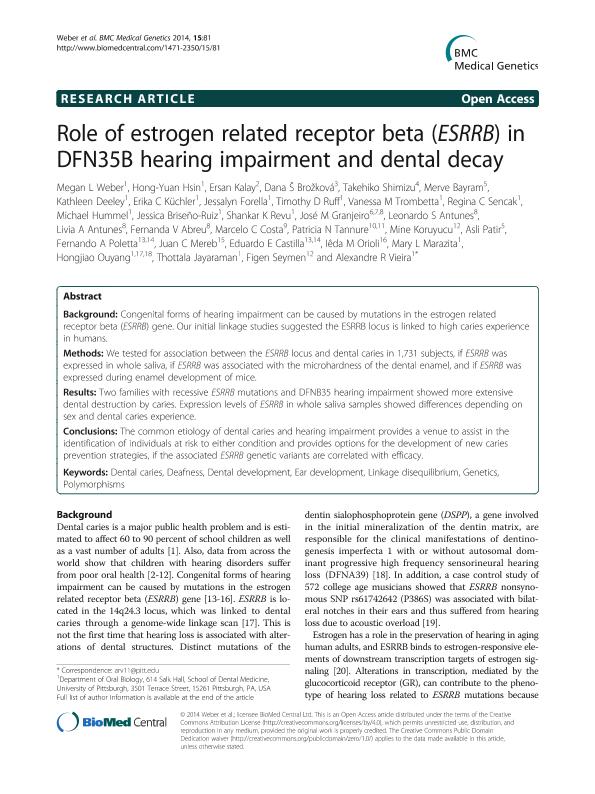Artículo
Role of estrogen related receptor beta (ESRRB) in DFN35B hearing impairment and dental decay
Weber, Megan L.; Hsin, Hong Yuan; Kalay, Ersan; Brožková, Dana Š; Shimizu, Takehiko; Bayram, Merve; Deeley, Kathleen; Küchler, Erika C.; Forella, Jessalyn; Ruff, Timothy D.; Trombetta, Vanessa M.; Sencak, Regina C.; Hummel, Michael; Briseño Ruiz, Jessica; Revu, Shankar K.; Granjeiro, José M.; Antunes, Leonardo S.; Antunes, Livia A.; Abreu, Fernanda V.; Costabel, Marcelo C.; Tannure, Patricia N.; Koruyucu, Mine; Patir, Asli; Poletta, Fernando Adrián ; Mereb, Juan C.; Castilla, Eduardo Enrique
; Mereb, Juan C.; Castilla, Eduardo Enrique ; Orioli, Iêda M.; Marazita, Mary L.; Ouyang, Hongjiao; Jayaraman, Thottala; Seymen, Figen; Vieira, Alexandre R.
; Orioli, Iêda M.; Marazita, Mary L.; Ouyang, Hongjiao; Jayaraman, Thottala; Seymen, Figen; Vieira, Alexandre R.
 ; Mereb, Juan C.; Castilla, Eduardo Enrique
; Mereb, Juan C.; Castilla, Eduardo Enrique ; Orioli, Iêda M.; Marazita, Mary L.; Ouyang, Hongjiao; Jayaraman, Thottala; Seymen, Figen; Vieira, Alexandre R.
; Orioli, Iêda M.; Marazita, Mary L.; Ouyang, Hongjiao; Jayaraman, Thottala; Seymen, Figen; Vieira, Alexandre R.
Fecha de publicación:
07/2014
Editorial:
BioMed Central
Revista:
BMC Medical Genetics
ISSN:
1471-2350
Idioma:
Inglés
Tipo de recurso:
Artículo publicado
Clasificación temática:
Resumen
BACKGROUND: Congenital forms of hearing impairment can be caused by mutations in the estrogen related receptor beta (ESRRB) gene. Our initial linkage studies suggested the ESRRB locus is linked to high caries experience in humans.
METHODS: We tested for association between the ESRRB locus and dental caries in 1,731 subjects, if ESRRB was expressed in whole saliva, if ESRRB was associated with the microhardness of the dental enamel, and if ESRRB was expressed during enamel development of mice.
RESULTS: Two families with recessive ESRRB mutations and DFNB35 hearing impairment showed more extensive dental destruction by caries. Expression levels of ESRRB in whole saliva samples showed differences depending on sex and dental caries experience.
CONCLUSIONS: The common etiology of dental caries and hearing impairment provides a venue to assist in the identification of individuals at risk to either condition and provides options for the development of new caries prevention strategies, if the associated ESRRB genetic variants are correlated with efficacy.
Archivos asociados
Licencia
Identificadores
Colecciones
Articulos(SEDE CENTRAL)
Articulos de SEDE CENTRAL
Articulos de SEDE CENTRAL
Citación
Weber, Megan L.; Hsin, Hong Yuan; Kalay, Ersan; Brožková, Dana Š; Shimizu, Takehiko; et al.; Role of estrogen related receptor beta (ESRRB) in DFN35B hearing impairment and dental decay; BioMed Central; BMC Medical Genetics; 15; 81; 7-2014; 1-10
Compartir
Altmétricas



